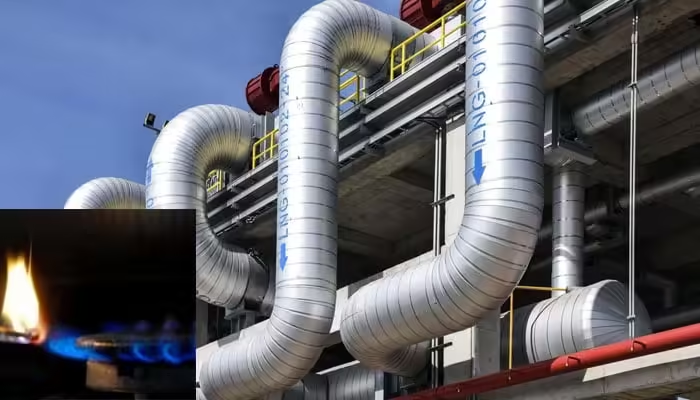Pakistan’s national gas transmission system is once again facing serious risks, according to senior officials from the Ministry of Energy. The situation has been attributed to the declining use of Re-gasified Liquefied Natural Gas (RLNG) by the country’s power sector, which has caused a significant increase in the line pack pressure of the gas pipeline. This rising pressure, if left unchecked, could lead to dangerous outcomes, including the potential bursting of the main transmission lines.
Understanding the Situation
On October 5, 2024, the line pack pressure in the national gas transmission system surged to around 5 billion cubic feet (Bcf). Line pack refers to the amount of natural gas stored in the pipeline system. If the pressure in the pipeline becomes too high, it poses a significant risk to the integrity of the gas transmission infrastructure. The increase in line pack pressure is primarily due to a sharp reduction in RLNG consumption by the power sector.
RLNG is a crucial component of Pakistan’s energy mix. The country relies heavily on imported LNG (Liquefied Natural Gas), which is re-gasified and injected into the national grid for distribution across various sectors, including power generation, industry, and domestic consumption. However, the recent drop in RLNG consumption by the power sector has triggered a build-up of pressure in the gas pipeline, leading to concerns about the safety and stability of the system.
The Decline in RLNG Consumption
According to government reports, the consumption of RLNG in the power sector has seen a drastic reduction over just a few days. On October 7, 2024, the daily consumption of RLNG dropped from 577 million cubic feet (mmcf) to 239 mmcf, marking a steep decline in the span of three days. The power sector, which typically plays a key role in utilizing RLNG, has not been consuming the expected amount of gas despite the steady inflow of imported LNG cargoes.
Pakistan imports approximately 10 LNG cargoes each month to meet its growing energy demands. However, the power sector’s inability to consume the deposited RLNG at the expected levels has contributed to the build-up of gas within the transmission system. This mismatch between supply and demand is at the core of the current crisis, as unused gas continues to accumulate in the pipeline network.
Potential Risks and Dangers
One of the major concerns surrounding the increasing line pack pressure is the potential for a pipeline rupture. The gas transmission system in Pakistan is a complex network of pipelines that transport both imported RLNG and locally produced natural gas. When pressure builds up beyond safe levels, the risk of a major disaster—such as a pipeline burst—increases dramatically.
A senior government official highlighted that repeated instances of high line pack pressure are especially dangerous. If the pressure continues to rise unchecked, the gas transmission system could face catastrophic failure, leading to widespread damage, service disruptions, and potential loss of life. The combination of local gas and RLNG in the pipeline adds further complexity, as any failure in the transmission line could have far-reaching consequences for the country’s energy supply and safety.
Addressing the Crisis
The government is aware of the potential risks posed by the current situation and is exploring ways to prevent a disaster. Officials from the Ministry of Energy and the gas utility companies are closely monitoring the pressure levels in the transmission system. However, the root of the problem—reduced RLNG consumption by the power sector—must be addressed to alleviate the pressure build-up.
To resolve the issue, there is a need for better coordination between the power sector and the gas suppliers. The power sector must ensure that it is using the RLNG that has been injected into the national grid. Additionally, alternative strategies, such as diverting excess gas to other industries or increasing storage capacity, could help manage the surplus RLNG and reduce the pressure in the system.
Challenges Facing Pakistan’s Energy Sector
Pakistan’s energy sector has long faced challenges related to balancing supply and demand. With growing reliance on imported LNG, the country has struggled to efficiently manage its gas transmission system. The current crisis highlights the need for better planning and infrastructure to ensure that the gas supply chain remains safe and reliable.
The gap between the power sector’s RLNG demand and its actual consumption levels must be bridged. This will require investment in infrastructure, improved forecasting, and stronger communication between different sectors of the energy industry. Without these improvements, Pakistan’s gas transmission system will remain vulnerable to recurring risks of over-pressurization and potential failures.
The threat to Pakistan’s national gas transmission system, driven by reduced RLNG consumption in the power sector, is a serious issue that must be addressed promptly. Rising line pack pressure poses significant risks, including the possibility of pipeline ruptures, which could have devastating consequences for the country’s energy supply and public safety.
To avoid a potential disaster, it is crucial for the power sector to increase its RLNG consumption and for the government to implement strategies that will help manage the excess gas in the system. In the longer term, Pakistan must continue to invest in its energy infrastructure to prevent similar crises from occurring in the future and ensure a stable and safe supply of energy for all sectors of the economy.



